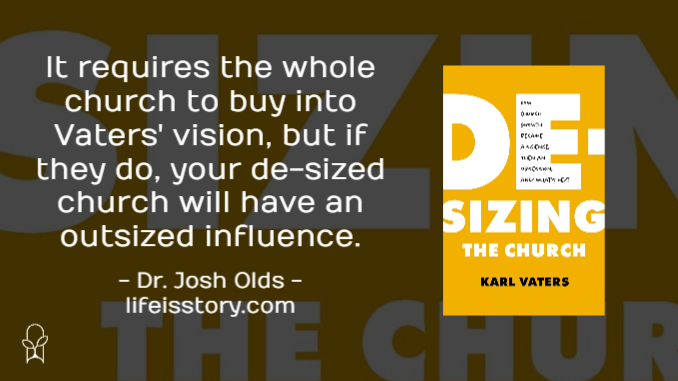
Published by Moody Publishers on April 2, 2024
Genres: Non-Fiction, Christian Life
Buy on Amazon
Goodreads

Big churches didn’t create the problems facing today’s congregations. But our obsession with size has come at a great cost.
We’re obsessed with bigness. Supersized meals and TV screens. Square footage. And big churches. “What’s the size of your church?” That question has stirred insecurities or stroked the ego of too many pastors.
For a long time, we thought bigger was better. “Church growth” and “numbers” dominated our thoughts and conversations. But more than ever, people are feeling disconnected. Trust in the church is dwindling.
In De-sizing the Church, pastor Karl Vaters takes us on a multi-faceted journey through our centuries-long obsession with size, both in and outside the church, and how it has negatively affected those who serve and worship in big and small congregations alike. He also dispels some prevailing myths and affirms what was good and true about the Church Growth Movement. And he invites us to consider how removing church size from the equation can be an essential element in rebuilding trust, restoring relationships, and renewing our spiritual lives.
In 2013, I accepted a job as a youth pastor at a church in Tulsa, Oklahoma, and served there until 2020. Across town in Tulsa, at a different church, there was very much a similar story. There was a youth pastor opening and someone from out a state found themselves a home as a pastor within that church. Full disclosure, I actually applied for that position as well—never heard anything back. In 2015 or so, that youth pastor and I became casual acquaintances and collaborated on some ministry things together for a couple years. Then, almost without warning—from my perspective—he was gone. The church, which had over 400 members in 2013, had dwindled to well under 100 and their youth program was almost non-existent. What caused such a radical shift? In 2015, a local megachurch opened up a satellite campus literally across the road from this historic community church. Big budget, big events, big entertainment, a huge staff subsidized by the other campuses—the mid-sized church that had been part of the community for decades just couldn’t compete.
In De-sizing the Church, small church pastor Karl Vaters traces the history of the church growth movement (which led to the proliferation of megachurches) and how that bigger-is-better obsession has led to negative consequences for churches both big and small. But even though Vaters has served within small-church communities for over forty years, he isn’t bitter about what the Church Growth movement has done. De-sizing the Church isn’t a screed against megachurches or a justification for keeping outsiders away. Rather, Vaters takes readers on a history of the Church Growth movement to evaluate its intentions, its goals, its successes—and where it lost its way.
A quote from the back cover copy captures it perfectly: “De-sizing is not thinking that big churches are bad—they’re not. It’s also not wanting churches to be smaller. De-sizing is not a refusal to look at or learn from numbers. De-sizing is about disconnecting our sense of value from our size.” In a consumeristic, capitalistic culture that is only sustained through continual growth, Vaters introduces a kingdom-minded community perspective that church health isn’t about butts-in-pews or dollars-in-coffers, but about being a faithful presence within the community that reflects the kingdom of God.
The first half of the book presents the background of the problem, taking readers through a history of the Church Growth movement. Part three shares the consequences of this obsession with size. Most relevant here is Vater’s assertion that Christian celebrity culture guarantees moral failure. The final part of the book gets into the practicalities of de-sizing. Vater offers practical checklists for readers to know if they need to de-size and how to do it. For example, in the chapter “De-sizing the Pastor,” Vater gives a ten-question Likert scale questionnaire for pastors to practically evaluate their own ministry. Much of the de-sizing that De-sizing the Church asks readers to do involves getting away from the pastor-as-CEO/church-as-entertainment model that can affect even small churches. Size is a concept, not just a number. Small churches striving for numerical size might indeed try the same things that big churches are trying, but their inevitable inability to compete will some lead them to falter. Rather, churches must offer an alternative to the consumeristic influences and instead build a community based on mutuality, equality, discipleship, and love.
De-sizing the Church is about looking at church from a different perspective—and how changing perspectives from a growth in numbers to a growth-in-Christ mentality can rebuild trust, restore relationships, prevent burnout and moral failure, and renew our spiritual lives. I will warn that this isn’t an easy task. It requires the whole church to buy into it. But if they do, and if you implement it, your de-sized church will have an outsized influence on its community.
